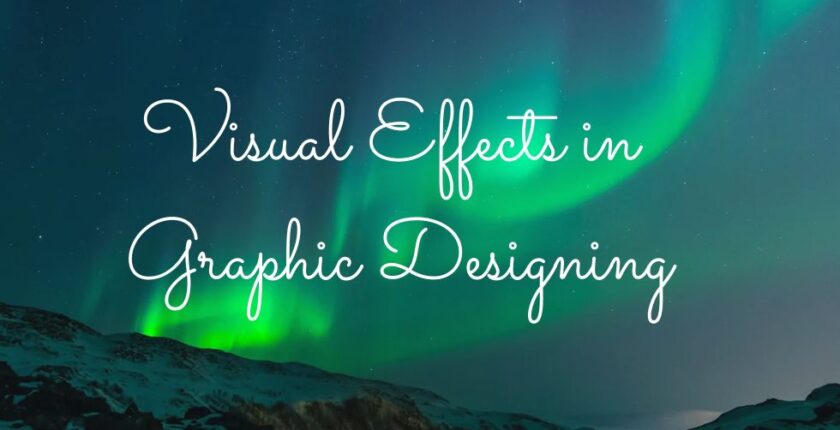Blog
Visual Effects in Graphic Designing
- April 19, 2018
- Posted by: Leher
- Category: Graphic & Web Design Blog

Visual Effects, or VFX, are images created or changed using digital technology. They enhance live-action footage. VFX are commonly used in movies, video games, TV, and ads. In graphic design, Visual Effects mean using digital tools to create or improve images. This adds realism or fantasy to movies, videos, and similar visuals.
Major Aspects of Visual Effects (VFX) in Graphic Design
 Digital Manipulation:
Digital Manipulation:
VFX uses software to create or change images. It combines live-action footage with Computer Generated Imagery (CGI).
Creating Realism or Fantasy:
Using VFX is a must when the production team needs to step away from reality. This includes adding unexpected elements to realistic scenes, like mythical characters or rare ideas.
Post Production Integration:
Visual Effects (VFX) is a post-production technique. It’s used for adding digital effects to scenes after they have been shot.
Compositing:
Compositing in Visual Effects (VFX) is about blending different layers of digital assets. This usually includes CGI and 3D elements mixed with live-action footage. The goal is to create a final image that looks realistic and feels like a single, cohesive whole.
Motion Graphics and Visual Effects (VFX)
Motion Graphics and VFX create exciting scenes. They often work together to enhance visuals. Motion Graphics serves as a tool to enhance visuals to create dynamic visuals within the given VFX projects.
Use of Visual Effects (VFX) in Graphic Design
 Visual Effects (VFX) in Graphic Design are mostly connected to the entertainment industry, particularly movies and videos. They help create dynamic and engaging visuals for different projects by focusing on these key aspects:
Visual Effects (VFX) in Graphic Design are mostly connected to the entertainment industry, particularly movies and videos. They help create dynamic and engaging visuals for different projects by focusing on these key aspects:
Depths and Dimensions: To make flat images look 3D, we use effects like shadows, gradients, and blurs for added depth and dimension.
Unifying Elements: Different design elements combine through color overlays, opacity changes, and blending modes. This creates a cohesive and attractive visual story.
Key Elements are highlighted to improve visual hierarchy. This helps draw attention to specific parts.
Simulating Real-World Phenomena: We create exciting effects like smoke, fire, and water to mimic real events. This adds realism and energy to visuals.
Motion Graphics: Visual Effects create animated videos and designs. They engage the audience and show the project’s creativity.
Data Visualization: VFX helps create dynamic data visuals. This makes it easier for the audience to understand and remember the information.
Interactive Elements: Fun effects make the user interface more engaging and boost the user experience.
Seamless Product Integration: VFX provides amazing visualizations through seamless product integration. This level of integration is not possible with traditional film production.
Major Software and Tools used for Visual Effects (VFX):
 Adobe After Effects: This software is mainly for motion graphics, compositing, and other visual effects. Compositing is key. It combines multiple images, videos, or 3D elements into one final image or video based on the need. This software is popular due to its versatility in integration with other Adobe Products.
Adobe After Effects: This software is mainly for motion graphics, compositing, and other visual effects. Compositing is key. It combines multiple images, videos, or 3D elements into one final image or video based on the need. This software is popular due to its versatility in integration with other Adobe Products.
- Autodesk Maya: It is one of the leading 3D Modelling, Animation and Rendering software. This software excels in the ‘Rendering’ process. It generates the final image or video from the composited elements. It also applies lighting, shading, and other visual effects.
- Houdini is popular for creating complex simulations and generating content procedurally. This software allows for automated content creation in games through Procedural Content Generation (PCG). It uses algorithms to generate game-related content. In Complex Simulations, the same algorithms model complex systems. These systems apply to movies, games, and other fields. Hence this software is much in use for the creation of visual effects and 3D animation in movies, video games, TV and above all Virtual Reality.
- Nuke is a strong node-based compositing tool. It excels at compositing and is flexible with high-resolution footage. It smartly combines visual elements through a network of interconnected nodes. Most importantly, it allows for flexible and non-destructive editing.
- Cinema 4D is a professional-grade 3D software. It’s commonly used for 3D modeling, animation, simulation, and rendering. These processes are key for motion graphics, visual effects, and related fields. This software is loved for its easy-to-use interface. It can also connect with other software as needed.
- Blender: This is open-source 3D computer graphics software. It has many features for making 3D models, animations, and visual effects, as well as rendering.
- Fusion: This is a great composting software used in movie production. It helps create motion graphics and visual effects based on needs.
- Z Brush: This is a 3D modeling, painting, and sculpting program. It’s used in various industries, not just entertainment. It helps create detailed models and is key for character design and texturing.
- AutoDesk 3Ds Max: This Autodesk 3ds Max is a top-notch tool for Visual Effects (VFX). It’s mainly used for 3D modeling, animation, and rendering. Professionals use it to create and modify 3D assets, characters, and environments. These elements are then added to movies, TV shows, and games.
- RenderMan: This is a photo-realistic 3D rendering software. It’s often used in the entertainment industry to create high-quality visual effects and animations.
Techniques of Visual Effects:
With the advancement in technology, there are various techniques of Visual Effects that are being employed today to get the optimum result as per the requirement and includes Composting, Matte Painting, Rotoscoping, Dynamic Simulation,3D Modelling and Animation, Chroma – Keying ,CGI, Bullet Time and Projection Mapping etc
Conclusion
In graphic design, visual effects (VFX) boost realism while adding fantasy elements. These effects help convey emotions better and work well with motion graphics. This combination creates a more engaging experience. The use of software depends on the needs of the project. It’s often combined with other tools to create stunning and engaging visual effects. As far as importance of Visual Effects in Movies and Television is concerned, it is not astonishing that the Visual Effects plays the major role in the above whether it is the movie of Hollywood or Bollywood. Even in South India the film production is focussing too much on Visual Effects to create stunning scenes. The evolution of Visual Effects can be traced back from 19th Century when in 1857, thirty two negatives were combined into a single image to give special effect. Right from Matte painting and Motion Capture to Chroma keying, Visual Effects add a next level of realism and depths to scenes. Right from transformation of next to impossible to possible, these Visual Effects bring stories to life. By the help of Visual Effects, special effects can be created without having to re-shoot the scenes multiple times and thus it aids in saving time and money of the concerned producers. With the passage of time coupled with the advancement in technology, the applications of Visual Effects are also increasing and are in great demand.
Beside this information if anyone wanted to upgrade their skill in the related domain than you must go for Advanced Diploma in Graphic & Web Design course from Leher School of Design (Delhi) which is one of the best and recommended for their courses

 Adobe After Effects: This software is mainly for motion graphics, compositing, and other visual effects. Compositing is key. It combines multiple images, videos, or 3D elements into one final image or video based on the need. This software is popular due to its versatility in integration with other Adobe Products.
Adobe After Effects: This software is mainly for motion graphics, compositing, and other visual effects. Compositing is key. It combines multiple images, videos, or 3D elements into one final image or video based on the need. This software is popular due to its versatility in integration with other Adobe Products.